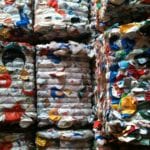Senator Brenner, Representative Tucker, and members of the Joint Standing Committee on Environment and Natural Resources, my name is Sarah Nichols, and I am the Sustainable Maine Director for the Natural Resources Council of Maine (NRCM). I appreciate this opportunity to testify in strong support of LD 1639. The time has come for Maine to stand up for its environment and people and stop being the dumping ground for New England’s construction and demolition debris waste.
The primary reason why the State bought the Juniper Ridge Landfill (JRL) in 2004 was to have the legal authority to prevent it from being filled with waste sent to Maine from other states. In the decades leading up to that purchase, other New England states passed strict disposal regulations, and the Supreme Court ruled that states cannot violate the commerce clause by preventing waste from one state from being disposed of in a commercial landfill in another state. Maine had already taken necessary steps to prevent new commercial landfills in 1989; and, by replacing them with publicly owned disposal facilities like JRL, Maine could prevent out-of-state waste from being dumped here. This move was intended to extend the operating lives of Maine’s existing landfills and lessen the need and cost to expand or site new landfills in the state. However, JRL has unfortunately become a dumping ground for out-of-state waste because of a loophole in Maine law.
- At least 30% of the waste landfilled at JRL each year is construction and demolition debris (CDD) that originated out-of-state. In 2019, that amounted to 235,396 tons, or the equivalent of sixteen forty-ton tractor trailer trucks dumping waste into JRL every single day of the year.
- The total weight of waste going to JRL has increased by 32% since 2012. The 2017 disposal amounts were 40% higher than the maximum amounts anticipated in 2004 and shows no sign of slowing down without legislative action.
- Between 2011 and 2019, one of Maine’s solid waste processing facilities in Lewiston, on average, received 89% of its waste from out of state, while only 11% was in-state waste.1 The processing being done only prevented 9% of all of the waste, both in-state and out-of-state, from going to a That means 91% of what the facility takes in ends up in JRL.
The landfill operator, New England Waste Services of Maine (NEWSME), LLC, a subsidiary of Casella Waste Systems, makes money from operating the landfill. They have consistently applied for, and been permitted by the State, to increase tonnage limits and expand the licensed capacity to accommodate a growing volume of waste, much of it from beyond Maine’s borders. This is a massive injustice to the people of Maine, particularly for the communities adjacent to the landfill.
The Legal Loophole
Maine law currently allows for out-of-state waste to be classified as in-state waste just by virtue of being delivered to one of Maine’s solid waste processing or incineration facilities. These facilities process the waste to reduce the weight and volume of waste needing to be landfilled. Then they send what is left over—or the residuals–to landfills. A few examples of the residual materials are incinerator ash, or a small ancillary part of waste processing—like packaging removed from food waste that has been digested, or “fines,” which are a soil-like material made from the processing of construction and demolition debris.
Most waste facilities in Maine process a majority of in-state waste, and the weight of the residuals going to landfill is not much. However, the problem here is that we have a waste processing facility that takes in a majority of out-of-state waste, doesn’t reduce the volume of material needing to be landfilled much at all, and then sends a significant amount of “residual material” that actually originated from out of state to JRL—and that is legal to do only through this process of recharacterizing the waste through minor processing. Clearly, this is a loophole that needs to be fixed, making it illegal for out-of-state waste to qualify for in-state landfill disposal in this fashion.
And it gets worse. Each solid waste processing facility in the state that creates residuals needing disposal must recycle no less than 50% of the waste that they process to maintain their facility permit. Maine law currently has a special carve out for one facility, which only must reduce or recycle 15% by 2022, and 25% by 2023, and they have special permission to be granted a waiver if they can’t meet these meager goals. This carve out is being given to the one facility that happens to also be sending about 200,000 tons of waste to JRL each year, the vast majority of which is material that originated from out of state. Our law gives them express permission to continue the business of bringing in out-of-state waste to be buried in JRL disguised as in-state waste. That isn’t right.
LD 1639 Closes the Loophole
Maine does not have a legal mechanism to prevent Maine’s commercial solid waste processing facilities from accepting out-of-state waste, and we recognize that these facilities need to dispose bypass and residue in landfills. However, we believe commercial solid waste facilities should not be permitted to dispose in State-owned landfills like JRL more tons of waste than they take in from true Maine-based sources. A requirement like this would close the loophole and make it impossible to disguise out-of-state waste as in-state waste. We also believe that each of Maine’s solid waste processing facilities needs to be fairly held to the same environmental standards.
NRCM believes that the State has failed adequately to protect JRL, an asset for the people of Maine, from being filled with out-of-state waste. This failure has opened the door for businesses that now exploit a loophole in Maine’s waste management laws and rules to accept out-of-state waste and accelerate the fill-rate at JRL. This outcome is negatively impacting the health and welfare of the communities adjacent to JRL and is antithetical to the intent of State landfill ownership. We believe it is the State’s responsibility to right that wrong by voting in favor of LD 1639. Please see the names of the 1,604 people who have sign a petition in support of LD 1639, attached.
1 See the attached table for the source data.













